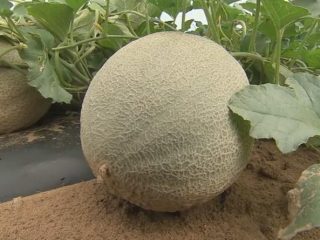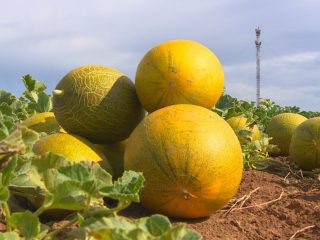Content
The Japanese are great masters in growing vegetables. They are skilled breeders and have bred many rarities that are famous all over the world not only for their amazing taste, but also for their exorbitant price. So is the Yubari melon.
Description of Japanese melon Yubari
The Japanese believe that the real King Yubari should be:
- perfectly round;
- have a well-defined mesh pattern and resemble ancient Japanese porcelain vases;
- have delicate orange flesh, very juicy.
The taste combines sharpness and sweetness, the spiciness of cantaloupe, the juiciness and sugariness of watermelon pulp, and a light but long-lasting pineapple aftertaste.
Melon King Yubari is a hybrid of two cantaloupes, otherwise called musk melons:
- English Earl's Favorite;
- American Spicy.
The hybrid variety bred in 1961 took the best from each of them. The weight of melons is small - from 600 g to 1.5 kg.
This is a powerful plant, the stems and leaves of which do not differ in appearance from other cantaloupes.
Features of cultivation
The area where the delicacy is grown is very limited: the small city of Yubari, located near Sapporo (Hokkaido island). The Japanese, famous for their high technology, have created ideal conditions for its cultivation:
- special greenhouses;
- automatically regulated air and soil humidity, which changes depending on the stage of plant growth;
- optimal watering, taking into account all the developmental features of the Yubari melon;
- feeding, correlated with the requirements of the melon at different stages of growth.
But the main condition that gives the Yubari melon an unforgettable taste, the Japanese consider the special soils in the place where it grows - they have a high content of volcanic ash.
In Russia, such soils can only be found in Kamchatka. But you can still try to grow Yubari melon on your own plot. The taste will most likely differ from the original, since careful adherence to growing technology in a conventional greenhouse cannot be achieved.
Seeds can be purchased in foreign online stores and from collectors of rare varieties in Russia.
Recommendations for growing:
- This variety ripens late, so it is grown through seedlings. In the southern regions, sowing directly into a greenhouse is possible. Yubari melon seeds are sown a month before planting in separate cups filled with fertile loose soil. Conditions for keeping seedlings: temperature about + 24 ° C, watering with warm water, good lighting and 2 feedings with a weak solution of fertilizer with microelements.Advice! Experienced gardeners advise soaking melon seeds for 24 hours in sweetened wine before sowing - the taste of the fruit will improve.
- The soil for growing Yubari melon must contain a lot of nutrients, be loose and have a reaction close to neutral. It is fertilized by applying per 1 sq. m bucket of humus and 1 tbsp. l. complex mineral fertilizer. But this plant will feel best in a warm bed prepared in advance.For the heat-loving southerner, full lighting throughout the day is very important. When choosing a landing site, this must be taken into account.
- Seedlings are planted when the soil warms up to + 18 ° C, the distance between plants is about 60 cm. They are first hardened off for a week, gradually accustoming them to fresh air. This technique is also necessary when growing plants in a greenhouse. Melon really does not like damage to the root system, so planting is carried out using the transshipment method. Planted plants are watered and shaded until they take root.
- If you plan to grow Yubari melon on a trellis, you need to take care of tying it to stretched ropes or pegs. If it is grown in a spread, a piece of plastic or plywood is placed under each resulting fruit to protect it from damage and possible rot.Important! The planted seedlings are pinched above the 4th leaf and only the 2 strongest shoots are left to grow.
- Water the plants with warm water as the top layer of soil dries. After the fruits are formed, watering is stopped, otherwise they will be watery. Overwatering should not be allowed - the melon root system is prone to rotting. When growing in open ground during this period, it is necessary to protect plants from precipitation by constructing temporary film shelters.
- At the beginning of growth, cantaloupe needs one fertilizing with nitrogen fertilizers; during flowering it will require phosphorus and potassium.
- In cool regions, plant formation is needed. After the formation of 2-3 ovaries, the Yubari melon lashes are pinched, retreating 1-2 leaves. They are also formed in open ground.
Melons are harvested when they are fully ripe. The signal is a change in color, the appearance of a mesh on the peel, and an increased aroma.
Yubari melon price
Among all the delicacies, King Yubari is in first place in terms of cost, ahead of black watermelon and ruby grapes. Even the insanely expensive white truffle cannot compare with it in terms of these indicators. The reason for such a high price is the peculiarities of the mentality and lifestyle of the Japanese. They are accustomed to appreciating everything perfect and beautiful, and the Yubari melon in this sense is the standard. The unusual taste and small growing region play an important role. It is simply impossible to grow it in other places: it does not reach the original in terms of taste. Delivery of ripened melons to other parts of Japan has only recently appeared. Before this, the exotic fruit could only be bought where it was grown - on the island of Hokkaido.
In Japan, it is customary to give delicacies as gifts for various holidays. Such a royal gift indicates the material well-being of the giver, which is important for the Japanese. Typically, melons go on sale in 2 pieces, with part of the stem that is not completely cut off.
Yubari melons begin to ripen in early May. The price for the first fruits is the highest. They are sold at auctions, which makes it possible to raise their value literally to the skies. So, in 2017, a pair of melons was purchased for almost $28,000. From year to year, the price for them only increases: limited production, which employs only 150 people, creates an insurmountable shortage. Thanks to the cultivation of this exotic berry, the economy of Hokkaido is stable. It provides 97% of the profits received from the agricultural sector.
All ripened melons are quickly snapped up by wholesalers, and from them they go on to retail sale. But even in a regular store, not every Japanese can afford this delicacy: the price for 1 piece can range from 50 to 200 dollars.
Those who definitely want to try King Yubari, but do not have the money to buy a whole berry, can go to the market. A cut piece of delicacy costs much less.
It is simply a sin to recycle such an expensive product. However, the Japanese make ice cream and caramel candies from Yubari melon, and use it to make sushi.
Conclusion
Yubari melon is the first in a series of exotic delicacies that command a high price. Not everyone will be lucky enough to get to Hokkaido during the harvest season and try this exotic fruit. But those who have their own plot can try to grow Japanese sissy on it and compare its taste with other melons.











